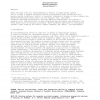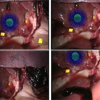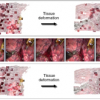CVRMED
1997
Springer
14 years 7 months ago
1997
Springer
There are many roles for electromechanical devices in image guided surgery. One is to help a surgeon accurately follow a preoperative plan. Devices for this purpose may be localiz...
MICCAI
2010
Springer
14 years 8 months ago
2010
Springer
The effectiveness and clinical benefits of image guided surgery are
well established for procedures where there is manageable tissue motion. In
minimally invasive cardiac, gastro...
Publication
Navigation during Minimally Invasive Surgery
(MIS) has recognized difficulties due to limited field-of-view,
off-axis visualization and loss of direct 3D vision. This can cause
...
MICCAI
2007
Springer
14 years 9 months ago
2007
Springer
The use of vision based algorithms in minimally invasive surgery has attracted significant attention in recent years due to its potential in providing in situ 3D tissue deformation...
10
posts
with
4940
views
4940
views
Peter Mountney
0
posts
with
0
views
0
views
I am a life long hands-on engineer who works with the human body as an engineered system. My focus to date has largely been simulation, navigation, and robotics applied to surgery ...
0
posts
with
0
views
0
views
 Homepage
Homepage ISBI
2006
IEEE
15 years 4 months ago
2006
IEEE
This paper describes the development and application of methods to integrate research image analysis methods and software with a commercial image guided surgery navigation system ...
IPMI
1999
Springer
15 years 4 months ago
1999
Springer
The estimation of soft tissue deformation from 3D image sequences is an important problem in a number of fields such as diagnosis of heart disease and image guided surgery. In thi...
134
click to vote
Presentation
A hand-held surgical probe is an essential component of any image-guided neurosurgery (IGNS). During the surgical procedure, the IGNS tracks the probe position and displays the ana...





